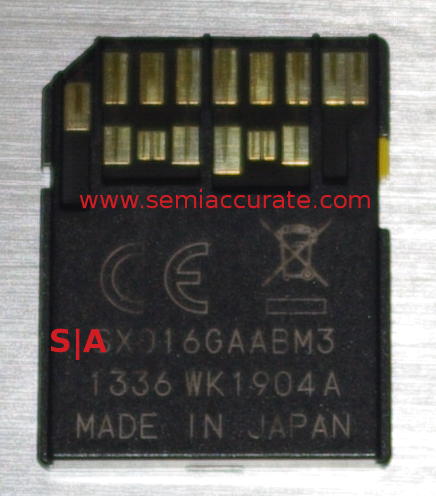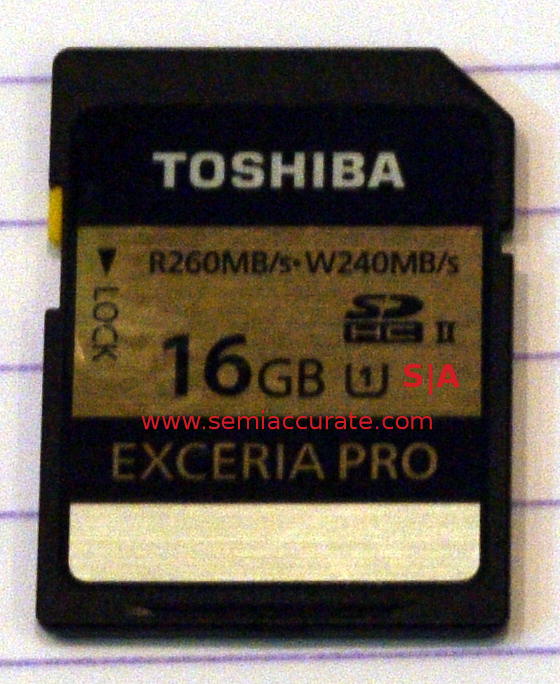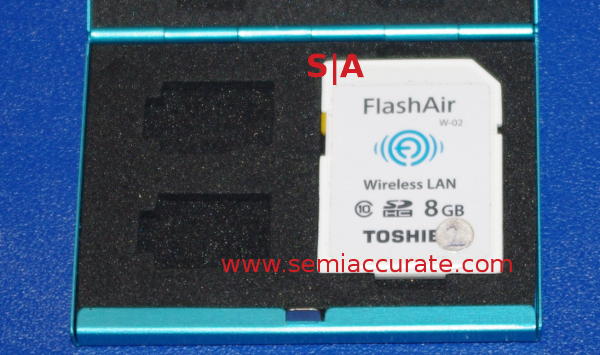![]() One Standard SemiAccurate didn’t remember existed until Toshiba showed it to us at Computex was SD card UHS-II. Unlike the older UHS-I standard, this new one has additional pins meaning a new physical format.
One Standard SemiAccurate didn’t remember existed until Toshiba showed it to us at Computex was SD card UHS-II. Unlike the older UHS-I standard, this new one has additional pins meaning a new physical format.

Note the added pins…
We have no idea when UHS-II aka SD v4.00 actually came out because the SD Association seems hell-bent on hiding it’s existence. Go to their main page and try to find it, you really have to know it exists to hunt it down. Even then the monumental change that it is, probably the largest in SD card history, seems to be an afterthought at the bottom of a buried chart. If you don’t want to look for it yourself, click here.

Find the UHS-II logo, just try!
If you look way back it was actually announced at CES in 2011 but we had never actually seen a UHS-II card until Computex 2014. Officially it raises the bus speed from 104MBps to 312MBps, half that for full-duplex and is only supported on HC and XC cards. These are suffixed with a II but the card speed marks, the U with a 1 or 3 in them are not changed. Unless you notice that little II after the card class, you won’t know that it exists unless you flip it over. In short it is about as bad a messaging and labelling job as you can reasonably expect from a product that actually functions.
Most of this push to show off their ancient but well hidden format is because of, you guessed it, 4K video. The older UHS-I bus was adequate for some forms of 4K video, it would not be sufficient for long. This is likely why we are seeing actual UHS-II hardware being made, it didn’t take three years from spec ratification to actually make one. That said UHS-II cards are finally here but good luck actually reading them at speed, they are backwards compatible but that misses the point.
Until UHS-II readers become ubiquitous, something we don’t expect to see soon with the utter pointlessness of new PCs, there is little reason to buy one. If you still have to have a device, Toshiba sells theirs under the Exceria Pro brand, Sandisk and Phison have versions as well.

FlashAir is not AirFlash
On a happier note, another product we didn’t know existed until Toshiba showed it to us was their FlashAir Wi-Fi SD card. It is effectively an Eye-Fi with 8-32GB of storage, 802.11n, and Class 10 transfer speeds so it should be fast enough for real world use. Since it is from Toshiba we expect it to actually live up to the speed rating but software support is, err, not their problem. In any case it is a good idea and we wish it were more ubiquitous, basically the same way we feel about UHS-II.S|A
Charlie Demerjian
Latest posts by Charlie Demerjian (see all)
- AMD outs MI300 plans… sort of - Apr 11, 2024
- Qualcomm is planning a lot of Nuvia/X-Elite announcements - Mar 25, 2024
- Why is there an Altera FPGA on QTS Birch Stream boards? - Mar 12, 2024
- Doogee (Almost) makes the phone we always wanted - Mar 11, 2024
- Intel Birch Stream Boards Speak From The SIde - Mar 6, 2024